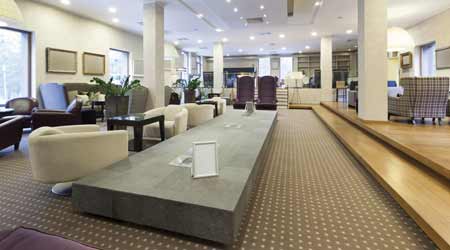 Control technology advances provide expanded capabilities, including the ability to tune a light source’s color output and to program the system’s responsiveness and behavior.
Control technology advances provide expanded capabilities, including the ability to tune a light source’s color output and to program the system’s responsiveness and behavior.Wireless Lighting Controls Have Changed The Game
A networked lighting control system allows managers to utilize sensor technology.
Managers also could consider wireless networked lighting control, which has changed the ballgame for practical expectations for existing buildings.
Networked lighting control is primarily an option for retrofits involving retrofit kits and luminaires. Essentially, the strategy connects all control points in a network. Each control point or switch-leg — zone — is individually addressable and, therefore, controllable. The entire system is programmable. Connection occurs via low-voltage control wiring or wireless signal. The wireless option offers an easier path to installation in existing buildings not undergoing a renovation.
The system might be room-based with a pre-configured sequence of operation that is basically left alone after installation. This is an easy solution — specifying luminaires as part of a connected lighting package—particularly for mid-sized and smaller buildings.
Networked lighting control provides the highest average lighting energy savings among control approaches. While savings varied widely, the average savings using networked lighting control were 47 percent, according to a 2017 DLC study that analyzed the performance of the systems for 1,200 zones in 114 commercial buildings.
To maximize savings, managers should write a controls narrative, or sequence of operations for each control point. This tactic ensures the system is functionally tested after installation, and it ensures operators are properly trained on its use. They also should work with a knowledgeable contractor.
While room-based connected lighting solutions are attractive for their simplicity, these systems operate in relative autonomy. Connecting control points across a building or enterprise provides the opportunity for properly trained operators to change the system as needed or to fine tune energy savings. It also presents an opportunity to collect performance. Managers can measure and analyze energy use and occupancy data, and they can monitor performance for maintenance purposes.
A networked lighting control system also enables managers to have sensors in a majority of spaces, connectivity and bandwidth. This provides a basic platform for integration with a building management system for more comprehensive energy management, facility responsiveness and occupant comfort, and it allows for the possibility of indoor location services and either integrating additional sensors or using lighting sensor raw data to be fed into third-party software — e.g., HVAC temperature set-back. This is the start of the Internet of Things (IoT) and could position a facility to take advantage of an array of analytics, services, and benefits.
Regardless of the lighting control option managers select, they should commission the system. Commissioning, along with having a knowledgeable contractor and operator, becomes more important the further one goes from standalone controls toward a building- or enterprise-based networked control system, which can function similarly to a wireless computer network.
The specifier should write a controls sequence of operations for each control point. The system then can be configured. Configuration varies in complexity, with some systems making it simple. The controls should be functionally tested after installation to ensure they operate in accordance with manufacturer instructions and manager requirements.
If controls are already installed, the manager should consider recommissioning. After installation, the manager should receive operating and maintenance manuals and a recommended schedule for recalibrating controls.
Craig DiLouie, LC, CLCP, IES, is education director for the Lighting Controls Association — www.lightingcontrolsassociation.org — a NEMA-administered council dedicated to promoting lighting controls through education.
Related Topics:














